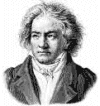
Ludwig van Beethoven
Ludwig van Beethoven was a deeply religious man, yet he hardly ever attended mass. Born a Catholic, he practiced little of its formalities. Beethoven's philosophy was more modern, akin to Eastern pantheism, a concept that there is an all-powerful being or purpose to the universe. His beliefs stemmed more from his inner personal struggles and also from his respect of the beauty of the natural world.
With this in mind, we can see that much of his music is a reflection of his philosophy, tormented and triumphant. He wrote just two overtly religious works, the
Mass in C and the
Missa Solemnis, both based on the traditional Catholic Mass.
The earlier
Mass in C is from 1807. Beethoven is a young man, successful, celebrated in Vienna and soon all of Europe. This is a happy time of his life which also produced the
Sixth Symphony and the
Piano Concerto no.3.
Each year to celebrate the nameday his wife, Prince Nikolaus Esterházy II would commission a new mass. In the previous 6 years, the task had been fulfilled by Haydn (once Beethoven's teacher), but in 1807 the commission fell to Beethoven and the
Mass in C was the result.
Daunted by stepping into such famous shoes, Beethoven was nevertheless pleased with the result. Unfortunately Prince Esterházy was not. He was expecting more traditional Haydn from the newcomer, and got unmistakable Beethoven. His description of the
Mass as “unbearably ridiculous and detestable” led to a falling out between Beethoven and himself.
While the melodies and structure of the
Mass in C are rooted deeply in the classical, even easily mistaken for Mozart or Haydn, Beethoven's originality must have shocked audiences (especially church audiences). The work opens not with an orchestral introduction, but the
Kyrie is announced by unaccompanied basses. Later parts of the
Sanctus are scored for voice and tympani alone. The
Gloria is almost shouted in ecstacy and then descends into the most profound
Miserere.
The
Mass in C has survived Prince Esterházy to become a great choral work. And while extremely fine, it is in fact surpassed by the
Missa Solemnis, Beethoven's most personal affirmation of faith.
The
Missa Solemnis comes from later in Beethoven's life, a much more difficult time which also brought forth the
Ninth Symphony and the final
String Quartets. By 1819, Beethoven was almost completely deaf. Love had eluded him. He plagued by illness and would die a few years after its completion. Yet Beethoven still wrote in its score “
To my God, who has never abandoned me”.
The
Missa Solemnis too had humble origins. Beethoven's patron was Archduke Rudolph, the brother of the reigning Emperor of Austria. In 1819, Archduke Rudolf was promoted to Cardinal and then Archbishop. To express his appreciation of his patron's benevolence, Beethoven commenced writing a Mass.
Beethoven immersed himself in the composition, studying church music history for a year, and putting his heart and soul into the new work. The date of Archduke Rudolf's installation came and went with no signs of the Mass being finished. It became clear to all, including the Archduke, that Beethoven's purpose had gone far beyond a simple celebratory Mass.
Beethoven's good friend Schindler (who wrote the text of the
Ninth Symphony) described Beethoven during this time as a man possessed, in a state of
Erdenentrucktheit, or oblivious of all earthly things.
“In the living room, behind a locked door, we heard the master singing parts of the fugue in the Credo – singing, howling, stamping…. the door opened and Beethoven stood before us with distorted features, calculated to excite fear. He looked as if he had been in mortal combat with the whole host of contrapuntists, his everlasting enemies” - Schindler
The result, in 1823, was one of Beethoven's greatest compositions. It encapsulated his deepest thoughts, his profound humility in the face of adversity, his triumph over fate, the dignity of humanity as a part of God's design.
The
Missa Solemnis is based very faithfully on the traditional Catholic Mass (see the full text
here), the five main sections
Kyrie, Gloria, Credo, Sanctus and
Agnus Dei subdivided into smaller sections.
Audiences by now had probably warmed to Beethoven's unconventional style and the
Missa Solemnis was and is seen as one of Beethoven's greatest works. More personal and grander than the Ninth Symphony, this is Beethoven's final testament.
Georg Solti demonstrates that he is a master of the grand choral genre. His performance and those of the soloists are superlative in this much-praised, budget priced recording. It is sung with respect, magnificence and tenderness. A prized CD.
Please support Good-Music-Guide.com
by purchasing this CD using this link.

Track Listing
Ludwig van Beethoven
Missa Solemnis opus 123
Chicago Symphony Orchestra
Georg Solti, conductor
Lucia Popp, mezzo-soprano
Yvonne Minton, mezzo-soprano
Dominic Walker, treble
Gwynne Howell, bass
Mass in C major opus 86
Bavarian Radio Symphony Orchestra
Riccardo Chailly, conductror
Margarita Zimmermann, soprano
Susan Dunn, soprano
Bruno Beccaria, tenor
Tom Krause, bass
Disc 1
Mass for soloists, chorus, & orchestra in C major, Op. 86
- I. Kyrie
- II. Gloria
- III. Credo
- IV. Sanctus
- V. Agnus Dei
Mass for soloists, chorus, & orchestra in D major ("Missa Solemnis"), Op. 123
- I. Kyrie
- II. Gloria: Gloria in excelsis Deo
- II. Gloria: Qui tollis
- II. Gloria: Quoniam
Disc: 2
Mass for soloists, chorus, & orchestra in D major ("Missa Solemnis"), Op. 123
- III. Credo: Credo in unum Deum
- III. Credo: Et incarnatus est
- III. Credo: Et resurrexit
- IV. Sanctus: Sanctus, Sanctus, Sanctus
- IV. Sanctus: Benedictus
- V. Agnus Dei: Agnus Dei, qui tollis peccata numdi
- V. Agnus Dei: Dona nobis pacem